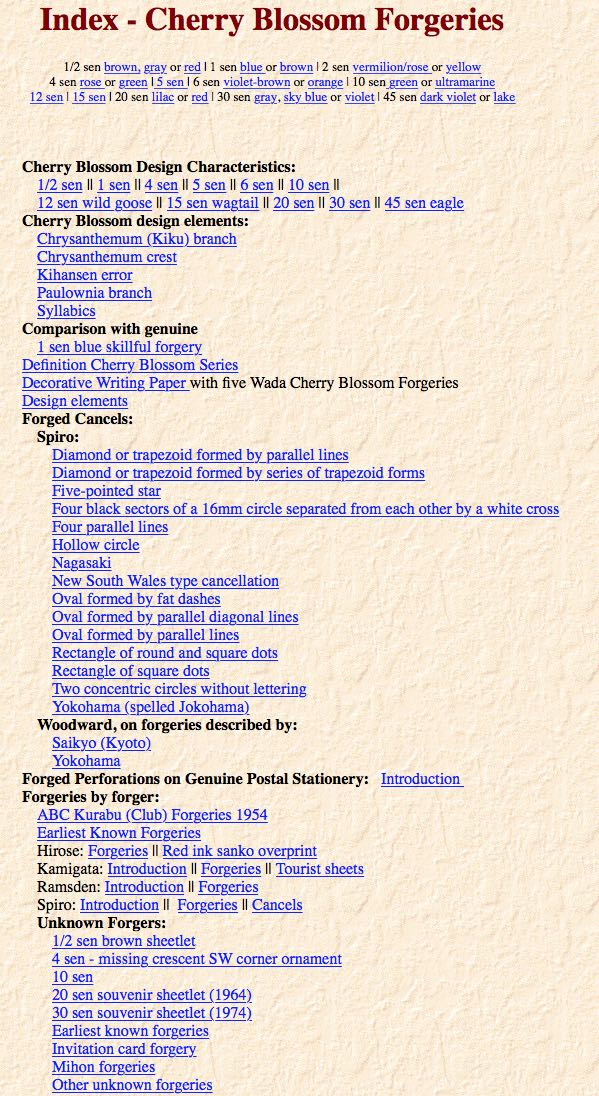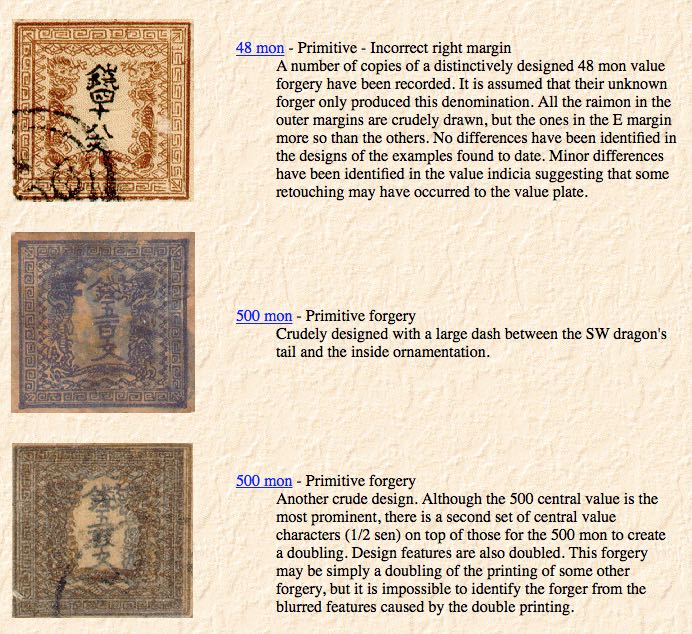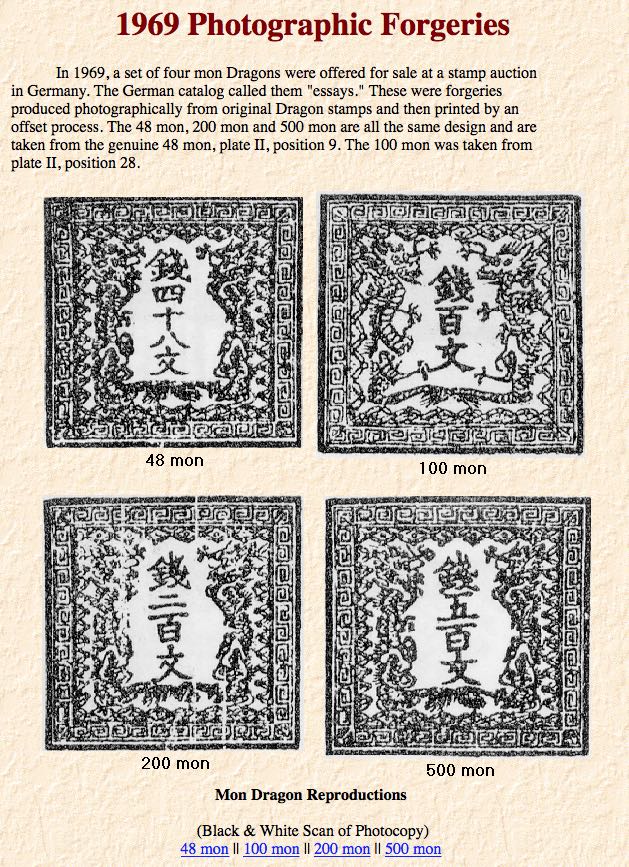Some imitations are signed with a mark; for the location of the mark, see: Lois M. Evans-de Violini, “Japanese Forgeries” (on CD-ROM cited below). a-m. Ron Casey, Thomas L. Zane and Lois M. Evans-de Violini, Forgeries of the Dragon, Cherry Blossom and Koban Postage Stamps of Japan, I.S.J.P. CD-Rom Monograph 1, 2nd Edition, 2002; an Update List is maintained by the I.S.J.P. at their website, http://isjp.org. m. George A. Fisher, Jr. “Notes on Postal Markings” Japanese Philately, Vol. 25 (October 1970): 215-21. a-e,i,l. W. Metzelaar and Varro E. Tyler, “Forgeries & Imitations Of The Dragon Stamps Of Japan”, Monograph 4, Japanese Philately, Vol. 26 (February 1971). a. Stanley Kronenberg, “The Spiro Reversed ‘S’“, Japanese Philately, Vol. 21 (June 1966): 140. g. Anon., “More Counterfeits”, Japanese Philately, Vol. 29 (June 1974): 130,31. a. Ron Casey, “Spiro Forgeries: Plate Production and Adaptations”, Japanese Philately, Vol. 50 (December 1995): 244-49, continued at Vol. 52 (February 1997): 4. a. Harold E.M. Bradshaw and Varro E. Tyler, Jr., “The Spiro forgeries of Japanese Stamps”, Japanese Philately, Vol. 15 (February 1960): 11-22. e,m. Kristian Wilhelmsen, “The Handstamps on Wada Forgeries”, Japanese Philately, Vol. 35 (December 1980): 291-302. a,m. Reverend R.B. Earée, Album Weeds/ How to Detect Forged Stamps (Third Edition), Vol. 1: 526-30; Paper LIX, Lowell Ragatz (editor), The Spud Papers/ An Illustrated Descriptive Catalogue Of Early Philatelic Forgeries, p.141. e. The 300m and 2s stamps: Harold E.M. Bradshaw, “Forgery Identification of Hand-Engraved Stamps”, Japanese Philately, Vol. 14 (April 1959): 41. l. Official reproductions distinguished: Michael E. Ruggiero, “Dragon Reproductions”, Japanese Philately, Vol. 50 (February 1995): 25,26; Scott Classic Specialized Catalogue (Nos.6,7). Three forgeries of the 48m, four forgeries of the 100m, two forgeries of the 200m, four forgeries of the 500m: Alden C. Johnson, Forgeries Old and New, Vol. 2, pp.23-31. Reprints, Geneva forgeries of the 48m, 500m and 5s, and other forgeries and fraudulent postmarks: The Serrane Guide/ Stamp Forgeries of the World to 1926, p.211 (Yvert 1-4 and 5-8). Andre Gely, “The Forged Classic Stamps of Japan And Their Expertication 1871-1875”, 1958, translated from the original French by Varro E. Tyler, Jr. and Chris Pickett, Jr., Japanese Philately, Vol. 18 (April 1963): 49-78. Forgeries of the Mon stamps: Arthur R. Gerhart, “Counterfeits of the Postage Stamps of Japan, Weekly Philatelic Gossip, Vol. 29 (December 2, 1939): 312,13, continued at (December 9, 1939): 340,41,51 (48m), at (December 30, 1939): 424,25 (48m), at (January 13, 1940): 480,81,90,91 (100m), at (January 27, 1940): 538,39,47,48 (200m), and at (February 17, 1940): 620,21,38,39,42 (500m); Francis Louise Duncan (age 17), “Early Issues of Japanese Stamps”, The Stamp Lover, Vol. 25 (February 1933): 277-79. Reprint of Scott 5 (no Syllabic): Varro E. Tyler, “Philatelic Heresy: Reprints of Japanese Stamps”, Japanese Philately, Vol. 35 (April 1980): 92-95. Characteristics of the genuine Mon stamps: E.F. Hurt, “Japan: The Forgeries Of The 1871-72 Issues”, The Record Of Philately, Vol.1, No.10 (January 1936): 112,13; J. Dorn (Publisher), The Forged Stamps of all Countries, pp.156,57





